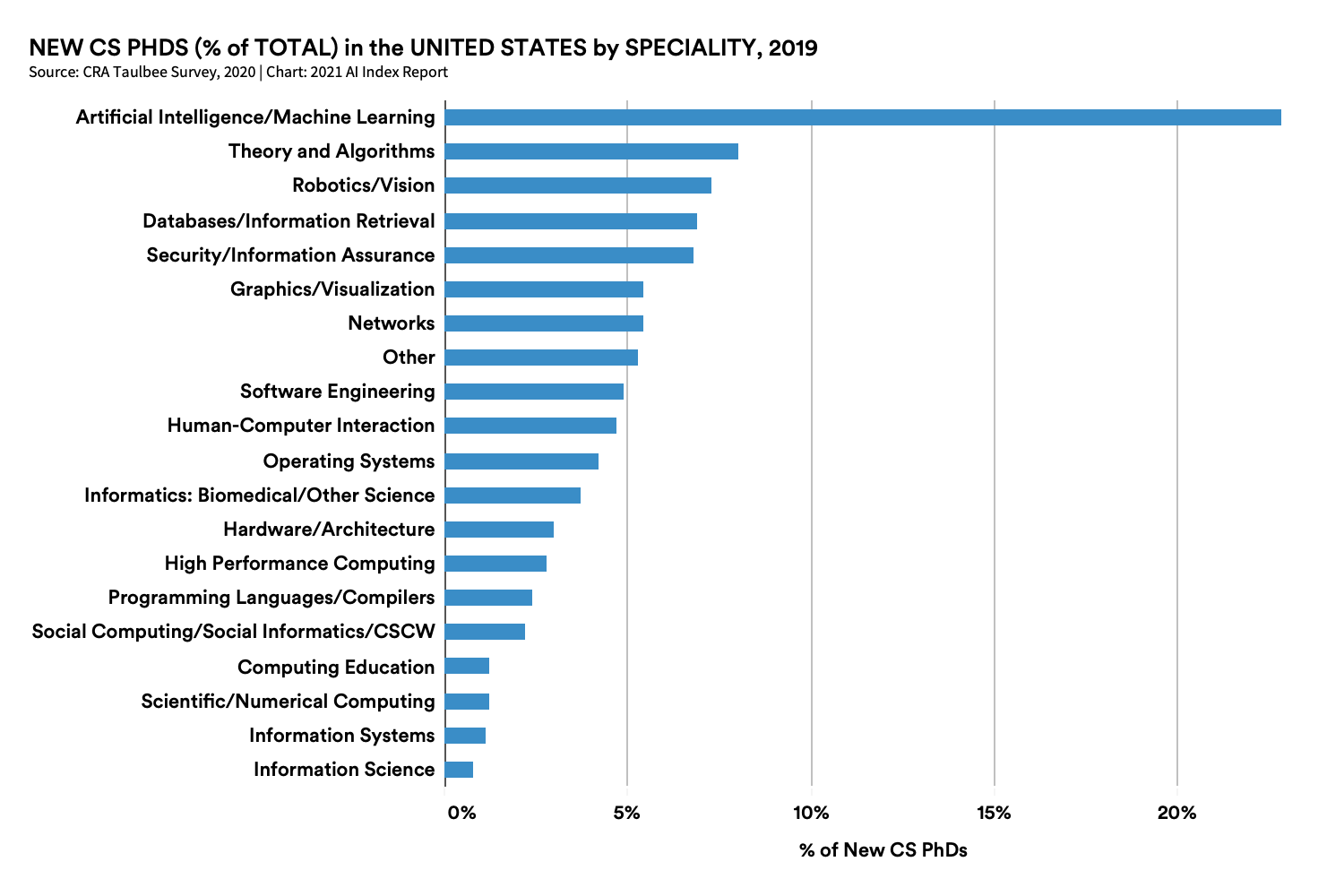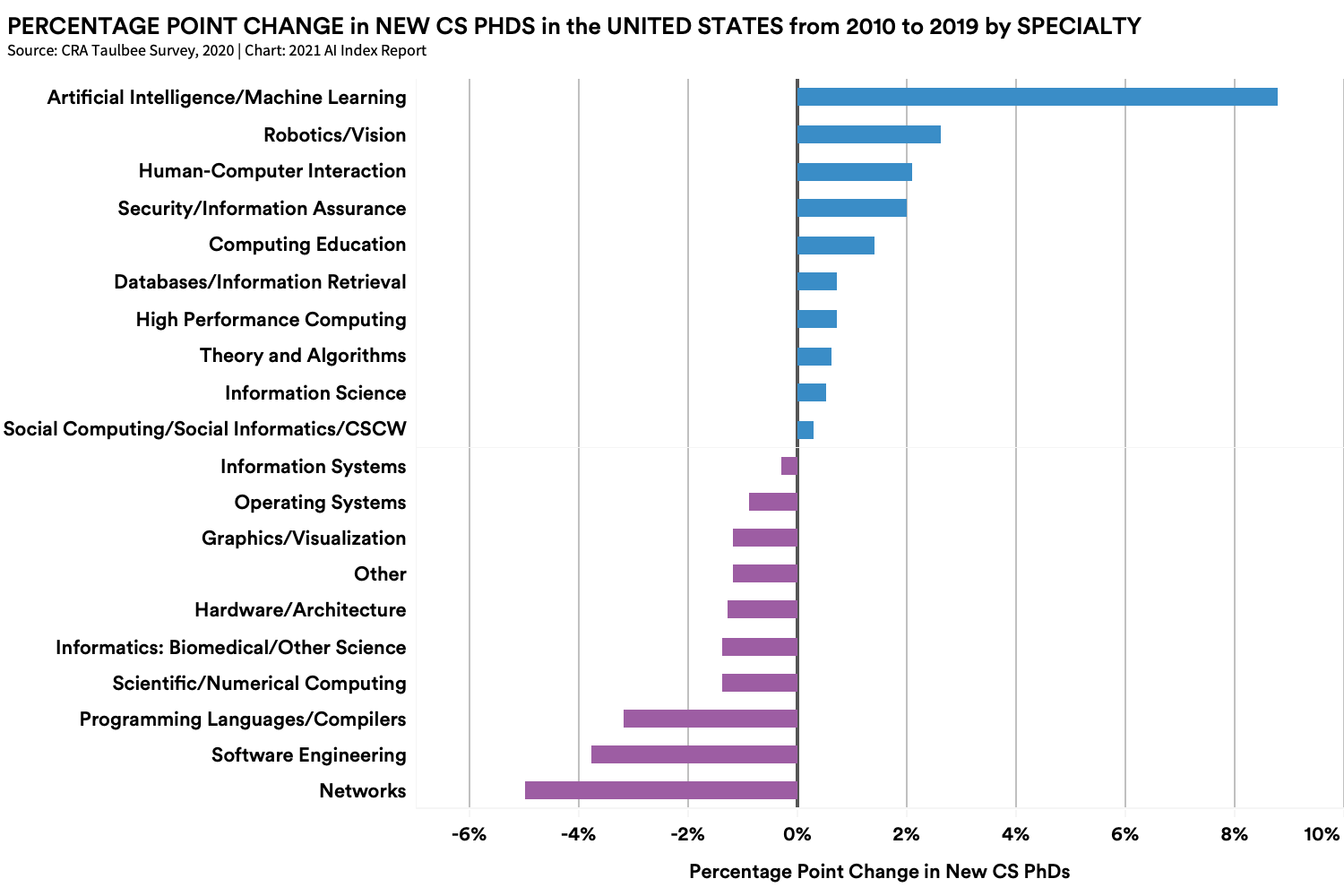The AI Index: Emerging Trends in AI Education
The fourth edition of the AI Index Report significantly expanded the amount of data and broadened the set of external organizations. The AI Index is a program at the Stanford’s Institute for Human-Centered Artificial Intelligence (HAI) that tracks, collates, distills, and visualizes data related to artificial intelligence. Its mission is to provide unbiased, rigorously vetted, and globally sourced data for policymakers, researchers, executives, journalists, and the general public to develop intuitions about the complex field of AI. The report aims to be the world’s most credible and authoritative source for data and insights about AI.
Global AI Vibrancy Tool: The fourth edition of the AI Index Report presents a revamped Global AI Vibrancy Tool, allowing for better interactive visualization when comparing up to 26 countries across 23 indicators. The updated tool provides transparent evaluation of the relative position of countries based on users’ preference; identifies relevant national indicators to guide policy priorities at a country level; and shows local centers of AI excellence for not just advanced economies but also emerging markets.
Measurement in AI Policy: In fall 2020, the AI Index published “Measurement in AI Policy: Opportunities and Challenges,” a report that lays out a variety of AI measurement issues discussed at a conference hosted by the AI Index in fall 2019.
Top 5 Takeaways
- The industry shift continues: In 2019, 65% of graduating North American PhDs in AI went into industry—up from 44.4% in 2010, highlighting the greater role industry has begun to play in AI development.
- Generative everything: AI systems can now compose text, audio, and images to a sufficiently high standard that humans have a hard time telling the difference between synthetic and non-synthetic outputs for some constrained applications of the technology.
- AI has a diversity challenge: In 2019, 45% new U.S. resident AI PhD graduates were white—by comparison, 2.4% were African American and 3.2% were Hispanic.
- The majority of the US AI PhD grads are from abroad – and they’re staying in the US: The percentage of international students among new AI PhDs in North America continued to rise in 2019, to 64.3%—a 4.3% increase from 2018. Among foreign graduates, 81.8% stayed in the United States and 8.6% have taken jobs outside the United States.
- AI ethics lacks benchmarks and consensus: Though a number of groups are producing a range of qualitative or normative outputs in the AI ethics domain, the field generally lacks benchmarks that can be used to measure or assess the relationship between broader societal discussions about technology development and the development of the technology itself. Furthermore, researchers and civil society view AI ethics as more important than industrial organizations.
AI Education Highlights
- An AI Index survey conducted in 2020 suggests that the world’s top universities have increased their investment in AI education over the past four years. The number of courses that teach students the skills necessary to build or deploy a practical AI model on the undergraduate and graduate levels has increased by 102.9% and 41.7%, respectively, in the last four academic years.
- More AI PhD graduates in North America chose to work in industry in the past 10 years, while fewer opted for jobs in academia, according to an annual survey from the Computing Research Association (CRA). The share of new AI PhDs who chose industry jobs increased by 48% in the past decade, from 44.4% in 2010 to 65.7% in 2019. By contrast, the share of new AI PhDs entering academia dropped by 44%, from 42.1% in 2010 to 23.7% in 2019.
- In the last 10 years, AI-related PhDs have gone from 14.2% of the total of CS PhDs granted in the United States, to around 23% as of 2019, according to the CRA Taulbee Survey. At the same time, other previously popular CS PhDs have declined in popularity. Networking, software engineering, and programming languages / compilers all saw a reduction in PhDs granted relative to 2010, while AI and Robotics/Vision specializations saw a substantial increase.
- After a two-year increase, the number of AI faculty departures from universities to industry jobs in North America dropped from 42 in 2018 to 33 in 2019 (28 of these are tenured faculty and five are untenured). Carnegie Mellon University had the largest number of AI faculty departures between 2004 and 2019 (16), followed by the Georgia Institute of Technology (14) and University of Washington (12).
- The percentage of international students among new AI PhDs in North America continued to rise in 2019, to 64.3%—a 4.3% increase from 2018. Among foreign graduates, 81.8% stayed in the United States and 8.6% have taken jobs outside the United States.
- In the European Union, the vast majority of specialized AI academic offerings are taught at the master’s level; robotics and automation is by far the most frequently taught course in the specialized bachelor’s and master’s programs, while machine learning (ML) dominates in the specialized short courses.
AI and CS Degree Graduates in North America
The annual Taulbee Survey from the Computing Research Association (CRA) documents trends in student enrollment, degree production, employment of graduates, and faculty salaries in academic units in the United States and Canada that grant doctoral degrees in computer science (CS), computer engineering (CE), or information (I). Academic units include departments of computer science and computer engineering or, in some cases, colleges or schools of information or computing. Most AI-related courses in North America are a part of the CS course offerings at the undergraduate level. The number of new CS undergraduate graduates at doctoral institutions in North America has grown steadily in the last 10 years (Figure 1). More than 28,000 undergraduates completed CS degrees in 2019, around three times higher than the number in 2010.

Figure 1
New CS PhDs in the United States
The AI Index examines the trend of CS PhD graduates in the United States with a focus on those with AI-related specialties.[1] The CRA Taulbee Survey includes 20 specialties in total, two of which are directly related to the field of AI, including “artificial intelligence/machine learning” and “robotics/vision”.
New CS PhDs by Specialty
Among all computer science PhD graduates in 2019, those who specialized in artificial intelligence/machine learning (22.8%), theory and algorithms (8.0%), and robotics/vision (7.3%) top the list (Figure 2.1). The AI/ML specialty has been the most popular in the past decade, and the number of AI/ML graduates in 2019 is higher than the number of the next five specialties combined. Moreover, robotics/vision jumped from the eighth most popular specialization in 2018 to the third in 2019.
Over the past 10 years, AI/ML and robotics/vision are the CS PhD specializations that exhibit the most significant growth, relative to 18 other specializations (Figure 2.2). The percentage of AI/ML-specialized CS PhD graduates among all new CS PhDs in 2020 is 8.6 percentage points (pp) larger than in 2010, followed by robotics/vision-specialized doctorates at 2.4 pp. By contrast, the share of CS PhDs specializing in networks (-4.8 pp), software engineering (-3.6 pp), and programming languages/compilers (-3.0 pp) experienced negative growth in 2020.

Figure 2.1

Figure 2.2
New AI PhDs Employment in North America
Where do new AI PhD graduates choose to work? This section captures the employment trends of new AI PhDs in academia and industry across North America.[2]
In the past 10 years, the number of new AI PhD graduates in North America who chose industry jobs continues to grow, as its share increased by 48%, from 44.4% in 2010 to 65.7% in 2019 (Figure 3). By contrast, the share of new AI PhDs entering academia dropped by 44%, from 42.1% in 2010 to 23.7% in 2019. These changes are largely a reflection of the fact that the number of PhD graduates entering academia has remained roughly level through the decade, while the large increase in PhD output is primarily being absorbed by the industry.

New International AI PhDs
The percentage of international students among new AI PhD graduates in North America continued to rise in 2019, to 64.3%—a 4.3 percentage point increase from 2018 (Figure 4). For comparison, of all PhDs with a known specialty area, 63.4% of computer engineering, 59.6% of computer science, and 29.5% of information recipients are international students in 2019.
Moreover, among foreign AI PhD graduates in 2019 in the United States specifically, 81.8% stayed in the United States for employment and 8.6% have taken jobs outside the United States. In comparison, among all international student graduates with known specialties, 77.9% have stayed in the United States while 10.4% were employed elsewhere.

Figure 4
About the Author
[1] New CS PhDs in this section include PhD graduates from academic units (departments, colleges, or schools within universities) of computer science in the United States.
[2] New AI PhDs in this section include PhD graduates who specialize in artificial intelligence from academic units (departments, colleges, or schools within universities) of computer science, computer engineering, and information in the United States and Canada.









